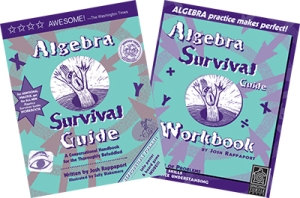Make Combining Integers a Lively Story
Who says you can’t have fun with integers?
For a number of years I’ve been using a fun story to explain the concept of combining integers with different signs. While I used to struggle at getting this concept across to certain kids, now, thanks to this story, there’s virtually no one who cannot grasp the concept when it is taught this way.
I’d like to share it with you now so you can use it, too.
The idea was first presented on p. 41 of my Algebra Survival Guide, along with a cartoon picture. The basic idea is that you can conceive of problems like: – 3 + 9, + 6 – 14, – 9 + 4, etc. as a tug-of-war.
Here’s the situation — there are two teams, a positive team and a negative team. To see this kind of problem as made of two teams, you have to look at it in a certain way, a way that may be new to some of you. Take a problem like – 3 + 9. You DO NOT view this as “negative 3 plus 9.” Rather, you look at it as make up of two parts: a – 3 part, and a + 9 part. [This has always made more sense to me anyhow.]
So … the “– 3” part tells us there are three people pulling on the negative team, while the “+ 9” part tells us there are nine people pulling on the positive team.
To avoid false assumptions, tell students that all people pulling are equally strong. In other words it would be impossible, for example, for 3 on the negative team to beat 4 on the positive team. Whichever team has more people pulling must win. [I’ll discuss the situation with equal numbers of people on both teams at the end of this entry.]
Then tell students they need to ask and answer just two simple questions to find the answer:
Q#1: Which team wins? [In – 3 + 9, the positives win because they have more people pulling.]
Q#2: By how many people does the winning team outnumber the losing team? [In – 3 + 9, the positives outnumber the negatives by 6, since they have 9 pulling compared to the negatives, who have just 3 pulling.]
When students put their answers together, they get the answer to the problem: + 6. Amazingly simple, huh? All it takes is looking at things in this fun new way.
I’ve put together a little template that you can reproduce and use to teach this rule in this way.
What follows is an example that shows in step-by-step fashion how students would input the data that leads them to the correct answer.
First we’ll show this for the problem: – 6 + 2
The empty template:
 Then students input the problem, – 6 + 2, and they write in how many people are on each team, like this:
Then students input the problem, – 6 + 2, and they write in how many people are on each team, like this:
Next students make tick marks to show the number of people pulling on the each team, 6 marks on the Negative Team side; 2 marks on the Positive Team side:
Next students answer the two questions, right on the template.

Finally students write in the answer, based on the answers to the questions.
Here’s another model of how students would use the template, this time for a problem whose answer is positive the problem: – 4 + 9

So that’s all there is to it. If you find anyone who cannot learn it this way, let me know. I’ll be amazed.
I suggest using the template for a few days, and then, once students have the idea down cold, let them go off the template. The nice thing is that even after they go off the template, if they get a wrong answer, a really wrong answer, like: – 3 + 5 = – 8, you can ask them to think this out as a tug-of-war, and they will virtually always get it right at that point. Cool, huh?
In a case where there are equal numbers of people on the positive and negative teams, the answer will be zero. Example: – 4 + 4 = 0. In terms of the tug-of-war, you might say this is a situation where neither team wins, and it ends as a tie. So a tie in the real world is a bit like 0 in the math world.
Feel free to leave comments on the blog on how well this works for you in your teaching.
And finally, if you don’t yet have my Algebra Survival Guide, it is loaded with analogies and metaphors just like this one. Teachers, parents, homeschoolers all enjoy and use this book.
50% OFF Sale for both the Algebra Survival Guide and Workbook at my website: SingingTurtle.com
Algebra Survival Guide: Regular Price $19.95 — Sale Price $9.95
Algebra Survival Workbook: Regular Price $9.95 — Sale Price $4.95
You can also purchase both the Guide and Workbook at Amazon.com
You’ll be able to download a sample chapter that includes the concepts in this post at SingingTurtle.com or Amazon.com
You’ll find that the Algebra Survival Guide has 173 Amazon customer reviews, with a 4.5 star rating!
Happy teaching!
— Josh










 Math Tutors, Santa Fe, NM
Math Tutors, Santa Fe, NM